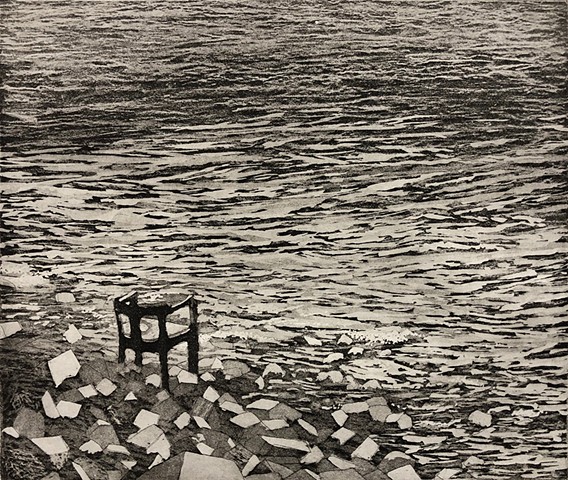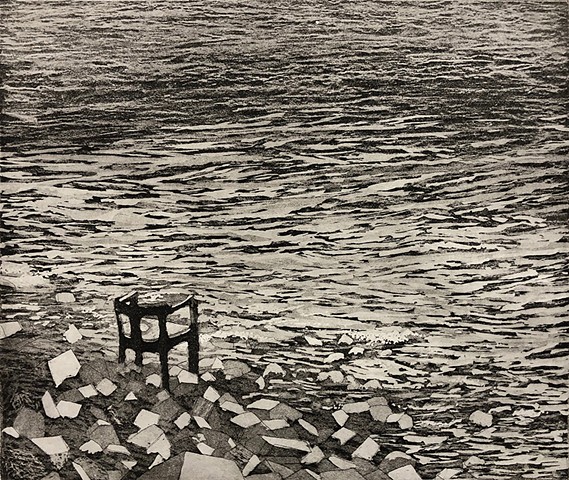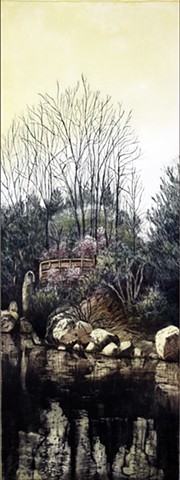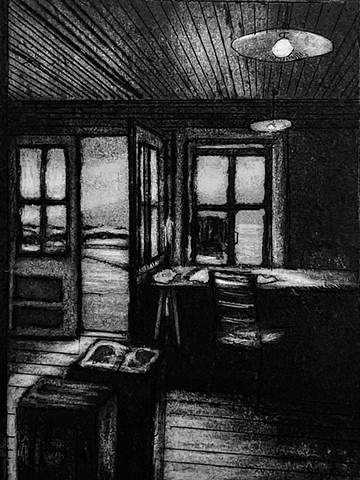Membership
I am a member of the California Society of Printmakers.
The California Society of Printmakers (CSP), a 501(c)3 non-profit organization, is the oldest printmaking organization in the nation. Originally founded in 1912 as the California Society of Etchers, it reflected a surge of printmaking activity on the West Coast during the early part of the 20th century. In 1968 the California Society of Etchers merged with the Bay Area Printmakers to form the present California Society of Printmakers.Currently, the CSP has a membership of approximately 250 artists, and welcomes new members twice each year. Though the majority of our members live and work in Northern California, membership is open to printmakers throughout the world.
The California Society of Printmakers archive is located at the Bancroft Library on the campus of at the University of California, Berkeley. The archive includes journals, newsletters, bulletins, minutes, exhibition information, correspondence and other miscellany.
Search the UC Berkeley online catalog, Pathfinder, using California Society Printmakers in the “author-organization keywords” field. The electronic finding aid assists locating CSP historical records from 1925 to the present. All of these materials are accessible to the public, but must be requested from storage five days in advance.
Additional historical resources include: CSP on Wikipedia and The Centennial Book.
Muskegon Museum of Art
"The Waters Began at Home" has been purchased by the Muskegon Museum of Art for the permanent collection 2022.
Metropolitan Museum of Art, Gallery Store at the Met
"The Waters Began at Home" etching and aquatint, is on view at the Gallery Store at the Metropolitan Museum of Art, October 2022 - January 2-23.
Ray and Nancy Loeschner Award
Awarded 1st place in the International Ray and Nancy Loeschner Competition, 2021, host by Frederik Meijer Garden and Sculpture Park. FMG permanent collection.
Society of American Graphic Artists
I have two prints that have been juried into the Society of America Graphic Artists, Mini Gem Exhibit. May-July 2022, SAGA Gallery, New York.
Boston Printmakers
I am a member of the Boston Printmakers
Our Town Juried Exhibition
Our Town 2014, is a juried exhibition held in Birmingham, MI. My print, Evening on Norris Creek, a multiple color woodblock, received the silver award.
Artists Alliance
I am a member of the Artists Alliance group of west Michigan. All members show is on view July 1-August 31, 2014 at the Holland Area Arts Council, 150th 8tth St. Holland MI, 49423 616 396 3278
Lithograph Exhibit in Grand Haven, MI
I have several lithographs on display in conjunction with, Portraits from the Past, hand tinted lithographs of Native American tribal leaders at theTri-Cities Historical Museum, 200 Washington St. Grand Haven MI 49417. It is on view through September.
Society of American Graphic Artists
I am a member of SAGA
History of SAGA
One of the senior artists' associations in America, the Society of American Graphics Artists (SAGA) has its origin in the Brooklyn Society of Etchers founded in 1915. The Society has been active from its inception, having organized over 78 National Member Exhibitions in addition to international, traveling and exchange exhibitions.In order to better appreciate the significance of SAGA's age, it must be kept in mind that the history of artists' associations is a relatively short one that does not go back further than the second quarter of the nineteenth century. One of the oldest organized groups of artists was the British Etching Club, founded in 1838. A closed circle, the club never exceeded sixteen members, who joined for purely artistic purposes.
The French Society of Etchers or Societe des Aquafortistes was founded twenty-four years later, but its purpose was commercial rather than artistic. Organized by publisher Alfred Cadart, the Society initially consisted of fifty-two members who were encouraged to regularly supply Cadart with etchings. The publisher, in return, developed a list of subscribers who received a monthly print for a standard fee - a sort of print-of-the-month club. Cadart's business venture lasted only five years, from 1862 to 1867, but it contributed to a revival of etching in France that would last through the end of the nineteenth century. It was in France that a number of American expatriate artists such as James Abbot McNeill Whistler and Mary Cassatt learned and became enamored with the etching technique.
As far as organization and purpose is concerned, SAGA was modeled neither on the British Etching Club nor on the Societe des Aquafortistes but on another French art association called, rather unimaginatively, the "Cooperative Society of Painters, Sculptors, Engravers, etc." The purpose of this society, better known as "the Impressionist group," was to organize exhibitions of the works of its various members.
Artists' societies and clubs organized along the impressionist model became popular in the later part of the nineteenth century, not the least among printmakers. In America, the oldest graphic arts association was the New York Etching Club, founded in 1877. The first meeting took place in the studio of James David Smillie with the mission to promote printmaking as a fine art form, both among artists and the public. Until then printmaking in America had been considered a "useful" technique, aimed at the reproduction of works of art (Gilbert Stuart's portrait of Washington, for example), for popular images (Currier and Ives prints), and for book and magazine illustrations. It is not surprising that etching became the preferred technique among those who promoted the notion of printmaking as a fine art form. On the one hand it was least suited to industrial usage and therefore lacked the association with popular and commercial imagery; on the other hand it had been used by many of the most famous graphic artists of the times, such as Rembrandt van Rijn, Jacques Callot, and Francisco Goya.
The New York Etching Club disbanded in 1893. The Brooklyn Society of Etchers officially organized in 1915 to continue the model of the New York Etching Club. Its founding members were Troy Kinney, Eugene Higgins, Fred Reynolds, Paul Roche, and Ernest Roth, who was the society's first president. The group's maiden exhibition in the Brooklyn Museum featured 197 etchings by sixty-five artists. Included among the exhibitors were such well-known artists as John Taylor Arms, Frank W. Benson, Mary Cassatt, Childe Hassam, John Marin, and Mahonri Young. By its second year the society had twenty-seven artist members and 135 associates. The latter were patrons of the society who, in return for their dues, received a print by one of the member artists each year.
During the first fifteen years of its existence, the membership of the Brooklyn Society of Etchers tripled. Its annual exhibitions, held in the Brooklyn Museum, grew from 197 prints in 1915 to 462 in 1931. In 1922 the society organized its first international exhibition (in the Anderson Galleries in New York), which included the works of several major European and American artists such as Mary Cassarr, Childe Hassam, Edward Hopper, Wilhelm Lembrook, Henri Matisse, Pablo Picasso, Camille Pissarro, and John Sloan.
As the membership of the society increasingly came from places outside Brooklyn, it was decided in 1931 to change its name to the Society of American Etchers, Inc. Henceforth the exhibitions were no longer held in the Brooklyn Museum but in the National Arts Club in New York. The growing membership include several artists who made their reputations in the 1930s, including Isabelle Bishop, Mina Citron, Kenneth Hayes, Stanley William Hayter, John Sloan and Reginald Marsh. During the thirties several new initiatives were taken. One of these was exhibit exchanges with European print clubs; the other, the organization of a special miniature print section in the annual shows.
In 1942, the society moved its annual exhibition to the National Academy. Thanks in part to the increased space, the exhibitions grew until, in 1947, the society organized the largest show in its history, consisting of 658 prints. Increasingly, these prints were done in techniques other than etching, such as woodcut, wood engraving, and lithography. This promoted the third renaming of the society in 1947, when it was called the Society of American Etchers, Gravers, Lithographers, and Woodcutters, Inc. Five years later, even that name was found to be not sufficiently inclusive and the current name of Society of American Graphic Artists was adopted.
In the course of SAGA's existence, printmaking has gone through many changes. Perhaps the most important among these is the shift from what we might call "hand" prints to decorative wall prints. The etchings that were produced during the early years of the Brooklyn Etching Club were not primarily intended to be framed and hung on the wall but rather to be kept in a portfolio to be looked at alone or with friends in a leisurely fashion. (Anyone familiar with the work of French nineteenth-century artist, Daumier will remember has images of print collectors, who lovingly leaf through their portfolios to admire the prints they contain.) Today prints are produced in first instance to be framed and hung. This means that they are generally larger and there is more emphasis on color. Neither color neither large formats are easy to achieve in etching but several newly invented printmaking techniques lend themselves to meeting those requirements. Indeed, the introduction of serigraphy (silkscreen), collography, and various mixed media techniques is another change that has taken place in American printmaking since 1915.
A final change concerns style and form. Printmaking has, of course, gone through the same changes as all other art and has witnessed the birth of non-objectivity, of surrealism, etc. A study of the catalogues of SAGA's exhibitions reflects these changes but it also shows SAGA's openness to all styles. In this respect the society has always followed the precept of its long time president John Taylor Arms (1931 - 52) who felt that SAGA should represent all techniques and styles in order to represent a true cross section of contemporary printmaking.
Petra ten-Doesschate Chu, PhD
Professor of Art History
Seton Hall University2013 West Michigan Area Show in Kalamazoo
I am currently showing in the juried West Michigan Area Show 2013
June 8 - August 31, 2013
West Michigan is home to a talented community of visual artists, and some of their finest recent work will be on display at the KIA in the annual West Michigan Area Show. Since the 1960s, this juried exhibition has drawn hundreds of entries from a 14-county region of Michigan.Michigan Arts, All Michigan-All Media Art Competition
I will be showing at the juried, All MI All Media Arts in Holland MI. September 12: reception 6-8 pm (open to the public) through
December 1. An opening reception and awards presentation is September 12 from 6:00- 8:00 at the Holland Area Arts Council, 150 E. 8th St. Holland, MI 49423.Lowell-Michigan Drawing & Print-Making Competition.
I have two prints accepted into the LowellArts! Michigan Drawing & Print-Making Competition. The exhibition will be on display in our King Gallery, 149 South Hudson, Lowell, Sept 10 – Oct 20. Closing Reception and Awards Presentation* on Sunday afternoon, October 20, from 2-4pm, at the Gallery
C2C Gallery showing of my original woodblock, drypoint prints.
June 1-29, 2013 I will have a show featuring my original woodblock relief with drypoint prints at the C2C Gallery in Grand Haven MI
Reception on June 9, from 6–8.
On the Way to Alma
On the Way to Alma is a woodblock relief print with drypoint.
Society of American Graphic Artists
Water Media Invitational
"Adde's Walk" a multiple woodblock relief print will be on view at the Walburg Gallery/Gallery Uptown, Grand Haven during the month of October, 2012. First Friday reception on Friday October 5, 5:30-8:00.
ArtWalk Grand Haven
"Five Mile Hill for Linda" oil painting is on view at the Frame and Mat Shop, Grand Haven MI, September 19-October 17, 2012
"Five Mile Hill" a color reduction woodcut is on view during ArtWalk at Odd Side Ales, Piano Factory building.
ArtPrize 2012
"Is it Someday?" a lithograph and color woodcut is on view at the Women's City Club during ArtPrize. September 19-October 17th.
Michigan All Media 2012
"Five Mile Hill" color reduction woodcut was juried into the 2012 Michigan All Media at the Ann Arbor Art Center, the show is on view through October 21, 2012.
International Society of Experimental Artists
"Moon Lilies" a color reduction woodcut was juried into the 2012 ISEA show in Gloucester MA. Show will be on view from September 21-October 21, 2012.
West Michigan Printmakers 2012
I will be one seven printmakers in the "West Michigan Printmakers" show at the Gallery Uptown, Walburg Gallery, Grand Haven, MI.
May 1-29, 2012.
The reception is on first Friday, May 4th from 5:30-7:30.
Convivial
Convivial: Feasting and enjoying the good company of others. My etchings, woodcuts and lithographs will be on view September 1-30, 2011. Reception is September 2 from 5:30-8:00
at the Gallery Uptown, 201 Washington Street, Grand Haven MI.West Michigan Printmakers
Five West Michigan Printmakers exhibit is on view at the Gainey Gallery, Van Singel in Byron Center through August 20, 2011.
An artist's reception is on Sunday, July 24, from 2:00 -3:30 pm
Gallery Hours
Monday - Thursday 12 -5
Closed July 1 - 18.




